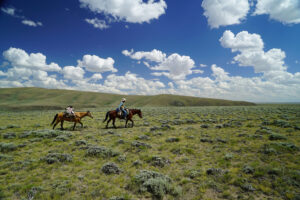Unlike most ghost towns, which grew out of mining, lumbering or agricultural ventures, Camp Rucker was a remote Arizona Territory cavalry post that became a ranching hub. In 1872 the government set aside the southeastern corner of the territory as the Chiricahua Indian Reservation. Four years later it closed the reservation and relocated the Chiricahuas north to the San Carlos Apache Indian Reservation. This in turn sparked a period of bloody raids by renegade Apaches.
In March 1878, to extend the Army’s reach in the region, Brevet Maj. Gen. Orlando B. Willcox, commander of the Department of Arizona, ordered establishment of a military supply camp in White River Canyon. Called simply Camp Supply, it was manned by Company C of the 6th Cavalry and two companies of Indian scouts—135 men in all.
The first permanent structure at the site was a civilian-run trader’s store and saloon, which became a popular drinking spot for off-duty personnel. Camp itself comprised tents and log buildings with canvas roofs, including a large kitchen/ mess/reading room and a hospital.
On July 11, 1878, Lieutenants John Rucker and Austin Henely and the Indian scouts under their command were returning to camp during a violent rainstorm that sent a torrent down White River Canyon. When Henely attempted to cross, the current swept him off his horse. Rucker rode in to save his friend but was also swept away. Both men drowned, devastating their scouts and fellow soldiers. The following spring the Army renamed the post Camp Rucker.
In September 1879 Apache Chief Victorio and his followers began an extended raiding campaign in the region. Three months later Geronimo, Juh and their followers surrendered in the Guadalupe Mountains and were escorted to San Carlos, staying four days at Camp Rucker. Still Victorio continued his attacks.
In 1880 work crews built several permanent buildings, including a bakery and commissary. Ranchers grazed large numbers of cattle in the area, and rustling was rampant. The post commander complained about one particular organized band of thieves, and on July 21 Lieutenant J.H. Hurst reported that cowboys had stolen six Army mules from the post. A Tombstone posse that included Virgil, Wyatt and Morgan Earp found the mules at the McLaury ranch, their brands altered from US to D8. The mules were never returned, and the Earps tangled with the Cowboys in the gunfight near the O.K. Corral a year and a half later.
Juh and Geronimo’s surrender had brought relative peace to the region, eliminating the need for a supply camp. The trader’s store closed in July 1880, and most of the troops left Camp Rucker for Fort Apache on November 22, leaving behind 13 men on picket duty. By then Mexican soldiers had tracked down and killed Victorio and his warriors. The Army abandoned Camp Rucker in July 1881.
On December 1, 1882, Mike Gray of Tombstone bought the trader’s store for $150 and the next year fled a “squatter’s claim” on the whole camp. He moved his family into the commissary building and bought a herd of New Mexico cattle from John Chisum. For the next six decades Old Camp Rucker Ranch would anchor the area’s ranching community, operating a post office off and on until 1929. In addition to his business and political connections in Tombstone, Gray was also friendly with a number of area rustlers, who were frequent visitors to his ranch.
Although the Army had formally abandoned Camp Rucker, it continued to use the land. In the weeks leading up to Geronimo’s fnal surrender in September 1886, Brig. Gen. Nelson Miles, buffalo soldiers of the 4th and 10th cavalries, Indian scouts and artillery units all used the property. The Army also stationed soldiers at Gray’s ranch following the 1890 murder of a visiting acquaintance by the Apache Kid and two others.
In late 1896 the ailing Mike Gray sold the ranch to artists Theodore and Mathilde Hampe. The Hampes improved the ranch buildings and in turn sold the property in 1919 to Charlie and Mary Kidder Rak. In 1921 the commissary/ ranch headquarters burned, and the Raks moved into a nearby ranch. During the Great Depression they sought a buyer for the land. In 1943 the Raks sold Old Camp Rucker Ranch to New York socialite Ella Dana, who in 1970 deeded the property to the U.S. Forest Service in a land exchange. Today the surviving buildings have been stabilized and stand adjacent to a popular campground.
Originally published in the April 2015 issue of Wild West. To subscribe, click here.




